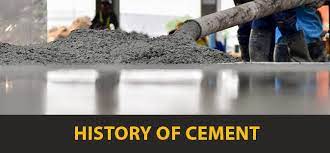The History of The First Cement, has been in use by humans throughout history; variations of the material were used up to 12,000 years ago, with the earliest archaeological discovery of consolidated whitewashed floor made from burned limestone and clay found in modern-day Turkey. The first fired clay bricks were developed in the so-called Fertile Crescent, where it was discovered that lime could be produced from burnt limestone to prepare mortar. Around 800BC, the Phoenicians used the knowledge that a mixture of burnt lime and volcanic ash, today called ‘pozzolana’, could be used to produce hydraulic lime, that was not only stronger than anything previously used, but also hardened under water.

The Romans developed new masonry techniques, with which they could erect grand buildings with heavy foundations. One such development was “opus caementitium”, a type of concrete made of lime with aggregates of sand and crushed rock. This was mostly used between masonry stones or bricks, serving as formwork. Other cements used crushed brick, tiles and ceramic pottery as aggregates. The Roman architect and engineer Marcus Vitruvius Polllio comprehensively described the knowledge and construction techniques of the time, which went on to to serve as the basis of building methods for hundreds of years.
Famous historical buildings made from concrete, still standing today, are the Colosseum and Pantheon in Rome, and the Hagia Sophia in Istanbul.
The Middle Ages
The Middle Ages were a quiet time in the history of cement; any discoveries made during this era remain unknown, although masons are known to have used hydraulic cements to build structures such as fortresses and canals.
In the guilds of the Middle Ages, knowledge was a secret and was pased on to students orally, not written down, whilst alchemists researched properties and reactivity of substances, often using coded language. Typical mortars from this time consisted of lime and sand – concrete as we know it did not yet exist.
The Industrial Revolution in Europe in the late 18th century saw a flurry of new developments in cement and concrete, with important contributions made by John Smeaton, who discovered that the hydraulicity of lime was directly related to the limestone’s clay content, James Parker, Louis Vicat and Egor Cheliev.
The Birth of Portland Cement:
The precursor to modern-day cement was created in 1824 by Joseph Aspdin, a British bricklayer and builder, who experimented with heating limestone and clay until the mixture calcined, grinding it and then mixing it with water. Aspdin named this Portland Cement, after the famously strong building stone from the Isle of Portland in Dorset, UK. His son, William Aspdin, made the first cement containing alite (an impure form of tricalcium silicate).
In 1845, Isaac Johnson fired chalk and clay at much higher temperatures than the Aspdins, at around 1400-1500oC, which led to the mixture clinkering, and produced what is essentially modern-day cement.
From 1850, the use of concrete made from Portland cement increased considerably. Projects such as sculptures, small bridges and concrete pipes were typical applications at the time and helped to increase its prominence. Then followed large scale sewage systems, such as in London and Paris, and the construction of metros and subways boosted demand. By the end of the 19th century, hollow concrete blocks for housing construction became mainstream.
The advent of reinforced concretes began in the 1840s in France, starting a period of innovation, using reinforced columns, girders and so on to allow the construction of larger bridges, taller and larger buildings etc, and significantly decreased the dominance of steel construction.
The first cement standard for Portland cement was approved in Germany in 1878, defining the first test methods and minimum properties, with many other countries following suit.
Cement production and applications surged globally at the turn of the century. Since the 1900s, rotary kilns replaced the original vertical shaft kilns, as they use radiative heat transfer, more efficient at higher temperatures. achieving a uniform clinkering temperature and produces stronger cement. Gypsum is now also added to the resulting mixture to control setting and ball mills are used to grind clinker.
Other developments in the last century include calcium aluminate cements for better sulphate resistance, the blending of Rosendale (a natural hydraulic cement produced in New York) and Portland cements to make a durable and fast-setting cement in the USA, and the increased usage of cementitious materials to store nuclear waste.
The Future of Cement and Concrete
New technologies and innovations are constantly emerging to improve the sustainability, strength and applications of cement and concrete. Some advanced products incorporate fibres and special aggregates to create roof tiles and countertops, for example, whilst offsite manufacture is also gaining prominence with the rise of digitalisation and AI, which could reduce waste and improve efficiency and on-site working conditions. Cements and concretes are also being developed which can absorb CO2 over their lifetimes, reducing the carbon footprint of the building material.
Cement as we know it was first developed by Joseph Aspdin, an enterprising 19th-century British stonemason, who heated a mix of ground limestone and clay in his kitchen stove, then pulverized the concoction into a fine powder.
The result was the world’s first hydraulic cement: one that hardens when water is added. Aspdin dubbed his creation Portland cement due to its similarity to a stone quarried on the Isle of Portland, off the British coast. In 1824, this brilliant craftsman obtained a patent for what would prove to be the world’s most ubiquitous building material, laying the foundation for today’s global Portland cement industry.
Manufacturing Process
Portland cement – a combination of calcium, silica, aluminum and iron – is the fundamental ingredient in concrete.
Producing a calcium-silicate Portland cement that conforms to specific chemical and physical specifications demands careful control of the manufacturing process.
First, the raw materials – limestone, shells or chalk along with shale, clay, sand or iron ore – are mined from a quarry that’s usually near the manufacturing plant. Before leaving the quarry these materials are reduced in size by two sets of crushers. The primary set crushes the stone to about five inches (125 mm) in diameter and the secondary set pulverizes it to just 3/4 inch (19 mm). Then the raw materials are sent to the manufacturing plant, where they are proportioned to create cements with specific chemical compositions.
Portland cement is manufactured using two methods: wet and dry.
In the dry method, dry raw materials are proportioned before being ground into a fine powder, blended, then fed dry into a kiln.
In the wet method, a slurry is created by adding water to properly proportioned raw materials prior to them being ground, blended and fed into the upper end of a tilted and rotating cylindrical kiln, where their rate of passage is controlled by the kiln’s slope and rotational speed.
Burning fuel – usually powdered coal or natural gas – is then forced into the kiln’s lower end, heating the raw materials to 2,600-3,000 degrees F (1,430-1,650 degrees C). At 2,700 degrees F (1,480 degrees C), several chemical reactions fuse the raw materials, creating what are called cement clinkers: grayish-black pellets the size of marbles.
The red-hot clinkers are discharged from the lower end of the kiln and transferred into various types of coolers to reduce their temperature so they can be handled safely. Now cooled, the clinkers are combined with gypsum and ground into a gray powder so fine that it can pass through a 75-micron – or number 200 mesh – sieve.
This fine gray powder is Portland cement.
Types of Portland Cement
The flexibility of Portland cement is evident in the different types, which are manufactured to meet various physical and chemical requirements.
The American Society for Testing and Materials (ASTM) Specification C-150 provides for eight individual types of Portland cement.
- Type I – For use when the special properties specified for any other type are not required.
- Type IA – Air-entraining cement for the same uses as Type I, where air-entrainment is desired.
- Type II – For general use, more especially when moderate sulfate resistance is desired.
- Type IIA – Air-entraining cement for the same uses as Type II, where air-entrainment is desired.
- Type II(MH) – For general use, more especially when moderate heat of hydration and moderate sulfate resistance are desired.
- Type II(MH)A – Air-entraining cement for the same uses as Type II(MH), where air-entrainment is desired.
- Type III – For use when high early strength is desired.
- Type IIIA – Air-entraining cement for the same use as Type III, where air-entrainment is desired.
- Type IV – For use when a low heat of hydration is desired.
- Type V – For use when high sulfate resistance is desired.
White Portland Cement
When architectural considerations require white or colored concrete or mortar, Portland cement can adapt with the manufacture of white Portland cement, just one of a number of special-purpose hydraulic cement types available.
White Portland cement is identical in composition to the traditional gray-colored product, except in color. This is made possible during the manufacturing process by selecting raw materials containing only negligible amounts of the iron and magnesium oxides that give Portland cement its gray color.
Blended Hydraulic Cements
Blended hydraulic cements, designed to conform to the special requirements of the ASTM C595 or C1157 standards, are produced by mixing Portland cement, ground and granulated blast-furnace slag, fly ash, natural pozzolans and silica fume. These cements may also designed as air-entraining, moderate sulfate-resistant or with moderate or low heat of hydration, depending on the need.
ASTM C1157-compliant cements include:
- Type GU – blended hydraulic cement for general construction.
- Type HE – high-early-strength cement.
- Type MS – moderate sulfate-resistant cement.
- Type HS – high sulfate-resistant cement.
- Type MH – moderate heat of hydration cement.
- Type LH – low heat of hydration cement.
The ASTM C1157-compliant cements can also be designated for low reactivity (option R) with alkali-reactive aggregates. There are no restrictions on the composition of C1157 cements. Manufacturers can optimize ingredients, such as pozzolans and slags, to achieve a particular set of concrete properties.
Of all the blended cements available throughout the world, Types IP and IS are the most common. While Europe and Asia currently use more blended cements than the United States, environmental and energy concerns, in addition to consumer demand for cements with specific properties, may alter this situation.
The History of The First Cement The History of The First Cement The History of The First Cement The History of The First Cement The History of The First Cement






